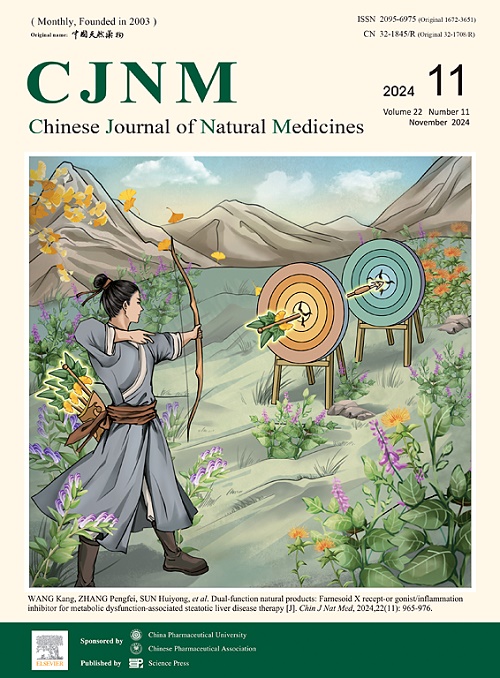Magnolol inhibits appetite and causes visceral fat loss through Growth/differentiation factor-15 (GDF-15) by activating transcription factor 4-CCAAT enhancer binding protein γ-mediated endoplasmic reticulum stress responses
IF 4.9
2区 医学
Q1 INTEGRATIVE & COMPLEMENTARY MEDICINE
引用次数: 0
Abstract
Magnolol, a compound extracted from Magnolia officinalis, demonstrates potential efficacy in addressing metabolic dysfunction and cardiovascular diseases. Its biological activities encompass anti-inflammatory, antioxidant, anticoagulant, and anti-diabetic effects. Growth/differentiation factor-15 (GDF-15), a member of the transforming growth factor β superfamily, is considered a potential therapeutic target for metabolic disorders. This study investigated the impact of magnolol on GDF-15 production and its underlying mechanism. The research examined the pharmacological effect of magnolol on GDF-15 expression in vitro and in vivo, and determined the involvement of endoplasmic reticulum (ER) stress signaling in this process. Luciferase reporter assays, chromatin immunoprecipitation, and in vitro DNA binding assays were employed to examine the regulation of GDF-15 by activating transcription factor 4 (ATF4), CCAAT enhancer binding protein γ (CEBPG), and CCCTC-binding factor (CTCF). The study also investigated the effect of magnolol and ATF4 on the activity of a putative enhancer located in the intron of the GDF-15 gene, as well as the influence of single nucleotide polymorphisms (SNPs) on magnolol and ATF4-induced transcription activity. Results demonstrated that magnolol triggers GDF-15 production in endothelial cells (ECs), hepatoma cell line G2 (HepG2) and hepatoma cell line 3B (Hep3B) cell lines, and primary mouse hepatocytes. The cooperative binding of ATF4 and CEBPG upstream of the GDF-15 gene or the E1944285 enhancer located in the intron led to full-power transcription of the GDF-15 gene. SNP alleles were found to impact the magnolol and ATF4-induced transcription activity of GDF-15. In high-fat diet ApoE-/- mice, administration of magnolol induced GDF-15 production and partially suppressed appetite through GDF-15. These findings suggest that magnolol regulates GDF-15 expression through priming of promoter and enhancer activity, indicating its potential as a drug for the treatment of metabolic disorders.
厚木酚通过激活转录因子4-CCAAT增强子结合蛋白γ介导的内质网应激反应,通过生长/分化因子-15 (GDF-15)抑制食欲并导致内脏脂肪减少
厚朴酚是一种从厚朴中提取的化合物,具有治疗代谢功能障碍和心血管疾病的潜在功效。其生物活性包括抗炎、抗氧化、抗凝血和抗糖尿病作用。生长/分化因子-15 (GDF-15)是转化生长因子β超家族的成员,被认为是代谢疾病的潜在治疗靶点。本研究探讨厚朴酚对GDF-15产生的影响及其潜在机制。本研究考察了厚朴酚对体内外GDF-15表达的药理作用,并确定内质网应激信号参与了这一过程。采用荧光素酶报告基因法、染色质免疫沉淀法和体外DNA结合法检测激活转录因子4 (ATF4)、CCAAT增强子结合蛋白γ (CEBPG)和ccctc结合因子(CTCF)对GDF-15的调控作用。本研究还研究了厚朴酚和ATF4对GDF-15基因内含子中一个假定的增强子活性的影响,以及单核苷酸多态性(snp)对厚朴酚和ATF4诱导的转录活性的影响。结果表明,厚木酚可触发内皮细胞(ECs)、肝癌细胞系G2 (HepG2)和肝癌细胞系3B (Hep3B)细胞系以及小鼠原代肝细胞中GDF-15的产生。GDF-15基因上游的ATF4和CEBPG或位于内含子的E1944285增强子的协同结合导致GDF-15基因的全功率转录。发现SNP等位基因影响厚朴酚和atf4诱导的GDF-15的转录活性。在高脂肪饮食ApoE-/-小鼠中,厚朴酚诱导GDF-15的产生,并通过GDF-15部分抑制食欲。这些发现表明厚朴酚通过启动子和增强子活性调控GDF-15的表达,表明其作为治疗代谢紊乱的药物的潜力。
本文章由计算机程序翻译,如有差异,请以英文原文为准。
求助全文
约1分钟内获得全文
求助全文
来源期刊

Chinese Journal of Natural Medicines
INTEGRATIVE & COMPLEMENTARY MEDICINE-PHARMACOLOGY & PHARMACY
CiteScore
7.50
自引率
4.30%
发文量
2235
期刊介绍:
The Chinese Journal of Natural Medicines (CJNM), founded and sponsored in May 2003 by China Pharmaceutical University and the Chinese Pharmaceutical Association, is devoted to communication among pharmaceutical and medical scientists interested in the advancement of Traditional Chinese Medicines (TCM). CJNM publishes articles relating to a broad spectrum of bioactive natural products, leading compounds and medicines derived from Traditional Chinese Medicines (TCM).
Topics covered by the journal are: Resources of Traditional Chinese Medicines; Interaction and complexity of prescription; Natural Products Chemistry (including structure modification, semi-and total synthesis, bio-transformation); Pharmacology of natural products and prescription (including pharmacokinetics and toxicology); Pharmaceutics and Analytical Methods of natural products.
 求助内容:
求助内容: 应助结果提醒方式:
应助结果提醒方式:


